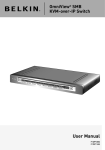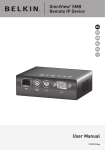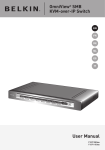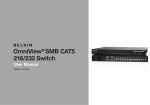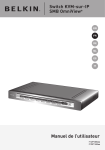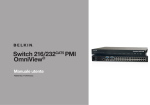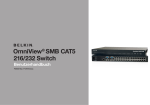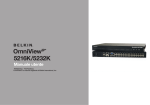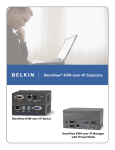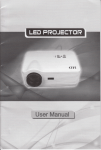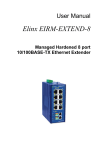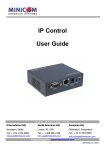Download Belkin F1DP101M User's Manual
Transcript
OmniView SMB
Remote IP Device
®
���
User Manual
F1DP101M
Table of Contents
1. Introduction...................................................................................... 1
Package Contents ......................................................................... 1
2. Overview .......................................................................................... 2
Features ......................................................................................... 2
Equipment Requirements .............................................................. 4
System Requirements ................................................................... 5
Unit Display Diagrams ................................................................... 7
Specifications ................................................................................ 8
3. Hardware Installation ...................................................................... 9
Pre-Configuration .......................................................................... 9
Mounting the IP Device (optional) ................................................10
Connecting the Console to the IP Device ....................................11
Connecting the KVM Switch or Server to the IP Device......................... 12
Powering Up the Systems ............................................................14
4. Remote Installation .........................................................................15
Identifying the IP Address ............................................................15
Logging into the Web Interface ....................................................16
Network Configuration..................................................................18
User Settings ............................................................................... 20
Switch Configuration ................................................................... 23
Serial Settings ............................................................................. 25
Security Settings ......................................................................... 26
Maintenance ................................................................................ 28
Table of Contents
5. Using the Remote IP Device ........................................................... 30
Starting a Remote Session .................................................................... 30
Using the Quick-Access Toolbar.......................................................... 32
Mouse Configuration and Settings ...................................................... 33
Keyboard Configuration and Settings ................................................ 37
Video Configuration and Settings ........................................................ 39
Performance Settings (Bandwidth) ..................................................... 41
Selecting a Server ................................................................................... 42
Additional Features.................................................................................. 43
Restoring Factory Defaults .................................................................... 44
6. Frequently Asked Questions .......................................................... 45
7. Troubleshooting ..............................................................................47
8. Glossary ......................................................................................... 49
9. Information .....................................................................................51
Introduction
Congratulations and thank you for purchasing the Belkin OmniView SMB
Remote IP Device (the IP Device). This IP Device provides a simple,
easy-to-use, remote server management solution for small- to medium-size
businesses. When connected to a KVM switch or server, the IP Device allows
you to access and control your servers over the Internet via a standard web
browser. This round-the-clock access enables you to troubleshoot servers
faster and more efficiently, reducing server downtime and service costs.
This User Manual provides all the details you’ll need to install and operate
your new IP Device, in addition to expert troubleshooting advice—in the
unlikely event of a problem. For quick and easy installation, please refer to
the Quick Installation Guide included in your packaging.
We appreciate your business and are confident that you will soon see for
yourself why over 1 million Belkin OmniView products are in use worldwide.
Package Contents
OmniView SMB
Remote IP Device
RS232
Cross Cable
1
Rack-Mount
Brackets
with Screws
One 5V DC, 2A
Power Supply
User Manual
PS/2
Cable Kit
Quick
Installation Guide
Overview
• High-Performance Remote Access
The IP Device allows you to access and control a KVM switch configuration
and all connected servers from any remote console over a TCP/IP connection.
The IP Device can also be set up to provide remote access to an individual
computer or server. The IP Device provides superior video quality and mouse
control, giving you the same user experience as if you were accessing your
servers locally.
• Web-Browser Based
The IP Device allows you to access your KVM switch and all connected servers
from any computer connected to the LAN, WAN, or Internet using Microsoft
Internet Explorer version 6.0 or higher.
• Universal Compatibility
The IP Device seamlessly adds remote, out-of-band access to any KVM switch
or individual server with PS/2-console connections. When connected to a
daisy-chained KVM configuration, the IP Device provides remote access to all
connected servers.
• BIOS-Level Access
1
2
3
4
5
6
7
8
9
The IP Device allows you to remotely access the basic input/output system
(BIOS) of your servers to make changes and perform reboots, regardless of
network connectivity or server condition.
• User-Friendly Interface
The web-based interface allows you to set up and change the IP Device’s
functions quickly and easily through your web browser, without having to install
additional software onto your servers.
• Remote Serial Access
The IP Device provides support for one serial device, such as a managed
power distribution unit (PDU), so you can remotely perform hard reboots of
your servers.
• Enhanced Security
The IP Device provides 128-bit Secure Sockets Layer (SSL) encryption and
password protection to prevent unauthorized access to your servers and
protect data transferred over the Internet.
2
section
Features
Overview
• Digital Collaboration
The IP Device enables one user to access and control servers remotely
over the Internet. Up to eight users can also simultaneously view
remote sessions to share technical expertise and troubleshoot servers
collaboratively.
• Video Resolution
The IP Device supports video resolutions of up to 1600x1200@75Hz for
both local and remote consoles.
• Firmware Updates
Flash upgrades allow you to obtain the latest firmware updates for your IP
Device. These firmware updates ensure that the IP Device is compatible
with the latest devices and hardware and are free for the life of the IP
Device. Visit www.belkin.com for upgrade information and support.
3
Overview
Equipment Requirements
To connect the IP Device to your KVM switch or individual server, the included
PS/2 KVM Cable Kit is required.
2
3
4
5
6
To connect the IP Device to your local area network, you will need to locate a
network cable with an RJ45 connector.
7
8
9
4
section
Cables
1
Overview
System Requirements
Host Computer Operating-System (OS) Platforms
The SMB Remote IP Device is compatible with CPUs running on, but not
limited to, the following OS platforms:
• Windows® NT®, 2000, XP, Server 2003, or VistaTM
• Microsoft® DOS 5.x and above
• Red Hat® Linux® 8.x and above
• Sun *
TM
• Novell® 5.x
• Solaris 8.x and above*
TM
*Adapters may be required.
KVM Switches
The IP Device is compatible with the following Belkin KVM Switches:
• OmniView Quad-Bus Series
• OmniView SMB Series
• OmniView PRO2 Series
• OmniView SE Plus Series
The IP Device is also compatible with KVM switches with PS/2-console ports
from other manufacturers including, but not limited to, the following:
• Avocent® Corporation
• Daxten
• ATEN
• Tripp Lite
• Raritan
• NTI
• Black Box®
• Adder
• Compaq®
• D-Link®
• HP
• CCC Networks
®
®
• IBM
• Rextron
• Minicom
• Emine
• Cybex
• KVM Partnership
®
5
• Rose
Overview
System Requirements
1
• PS/2-compatible
2
Mice
3
• PS/2-compatible with 2, 3, 4, or 5 buttons
4
• PS/2-compatible wireless and optical mice
5
Monitors
• CRT and LCD (with VGA support)
6
Remote-Console Software
7
The SMB Remote IP Device may be accessed remotely over a TCP/IP
connection from computers using the following web browsers and OS platforms:
• Microsoft Internet Explorer 6.0 and above with ActiveX support
®
• Windows 2000, XP, or Server 2003
8
9
• Windows Vista**
**Internet Explorer® must be run under administrator mode due to extra security
for ActiveX plug-ins under Windows Vista.
6
section
Keyboards
Overview
Unit Display Diagrams
Front View
PS/2 Mouse
Console Port
Ethernet
Port
VGA Monitor
Console Port
PS/2 Keyboard
Console Port
Back View
Go Local/
Reset Button
Serial-Device Port
KVM/Server
Port
Power
Jack
Power
Status LED
7
Overview
Specifications
1
F1DP101M
No. of Users Supported:
1 digital or 1 local
Enclosure:
Aluminum
Power Requirements:
3.3V DC, 1.3A power adapter
(center-pin negative)
Video-Resolution Support:
Local analog port: Up to 1600x1200 @ 75Hz
Digital port: Up to 1600x1200 @ 75Hz
Console Keyboard Emulation: PS/2
Console Mouse Emulation:
PS/2
Console Keyboard Input:
MiniDIN6 (PS/2)
Console Mouse Input:
MiniDIN6 (PS/2)
Console Monitor Port:
HDDB15 female (VGA)
KVM/Server Port:
HDDB15 female*
Ethernet Port:
RJ45 (10/100Base-T connection)
Security:
128-bit SSL encryption
Typical Bandwidth:
0.31Mbps**
Serial-Device Port:
RJ45
Power Connection:
IEC
Port Selectors:
8 and 16 respectively for 8- and 16-port models
LED Indicators:
8 and 16 respectively for 8- and 16-port models
Dimensions:
1.1 x 4.1 x 3.1 in. (28 x 104 x 79mm)
Weight:
0.5 lbs. (0.2kg)
Operating Temp:
32° to 104° F (0° to 40° C)
Storage Temp:
-40° to 158° F (-40° to 70° C)
Humidity:
0-80% RH, non-condensing
Warranty:
2 years
2
3
4
5
6
7
8
9
*The IP Device may be connected to any KVM switch or individual server with
PS/2 keyboard and mouse console ports.
**Typical bandwidth is defined as typical “non-intensive” administrative use at
16-bit color, 1024x768 resolution.
Note: Specifications are subject to change without notice.
8
section
Part No.:
Hardware Installation
Pre-Configuration
�����������
�������
���������
�����������
���������
�
���
���
������
����������
�����������
(Typical configuration)
Where to place the IP Device:
The IP Device includes a mounting bracket and is designed for stand-alone or 0U
rack-mount installation.
Consider the following when deciding where to place the Switch:
• whether or not you intend to use the included bracket
• the lengths of the cables attached to your keyboard, monitor, and mouse
• the location of your KVM switch or server in relation to your console
• the lengths of the cables you use to connect your IP Device to the KVM switch
or server
Warning: Avoid placing cables near fluorescent lights, air-conditioning
equipment, or machines that create electrical noise (e.g., vacuum cleaners).
9
You are now ready to begin installation of your IP Device. The following
sections (pages 10–14) provide complete instructions for the hardware
setup of the IP Device to a KVM switch or individual server.
Hardware Installation
Step 1 Mounting the IP Device (optional)
MAC Address
Device Number
2
3
4
1.1 Attach the included mounting bracket to either side of the IP Device.
(Refer to diagram below.)
5
6
7
���
8
9
1.2 Mount the IP Device to the rear post of your rack.
(Refer to diagram below.)
Note: Mounting screws for the rack are not included. Please use the specified
screws from your rack’s manufacturer.
10
section
Note: Before you begin, locate the MAC address and device number on the
bottom of the IP Device. You will need these numbers later in the installation
process, so it is highly recommended that you record these numbers below
before mounting the IP Device to your rack.
1
Hardware Installation
Step 2 Connecting the Console to the IP Device
2.1 Connect your monitor VGA cable to the monitor port on the front of the
IP Device labeled “
.” (Refer to diagram below.)
���
2.2 Connect your keyboard and mouse PS/2 cables to the keyboard
and mouse ports on the front of the IP Device. (Refer to diagram below.)
���
11
Hardware Installation
2.3
Locate and connect a cable from your local area network to the
RJ45 Ethernet port on the back of the IP Device. (Refer to
diagram below.)
1
2
4
���
5
6
7
8
9
Step 3 Connecting the KVM Switch or Server
to the IP Device
3.1 Make sure your KVM switch and all connected servers are powered off.
3.2 Using the included KVM cable kit, connect the single DB15 connector
to the “KVM In” port on the back of the IP Device. (Refer to
diagram below.)
�����
������
������
�
��������
�������
12
section
3
Hardware Installation
3.3 Using the other end of the cable kit, connect the VGA and PS/2 cables
to the console monitor, keyboard, and mouse ports on your KVM switch
or server. (Refer to diagrams below.)
Connecting to a KVM Switch
�����
�
������
������
��������
�������
�����������
�������������������������
����������������
��������
���
������
����
������
����
������
���
������
���
������
������
���
������
���
�����
����������
���
Connecting to a Server
�����
�
������
������
��������
�������
�����������
�������������������������
����������������
��������
���
13
������
����
������
����
������
���
������
���
������
���
������
���
������
���
�����
����������
Hardware Installation
Step 4 Powering Up the Systems
1
4.1 Attach the power adapter to the IP Device and connect it to a
power source to power up the IP Device. (Refer to diagram below.)
������
������
�
��������
�������
3
4
5
6
7
8
4.2 Power on the KVM switch or server connected to the IP Device. The IP
Device emulates both a mouse and a keyboard on each port, and allows
your KVM switch or server to boot normally.
9
4.3 Power on all servers connected to your KVM switch.
4.4 Check that the local keyboard, monitor, and mouse are
working normally.
14
section
�����
2
Remote Installation
Initial Settings
The following section provides instructions for setting the IP address for the
OmniView SMB Remote IP Device.
Step 1 Identifying the IP Address
Once your IP Device has been connected to your network and is powered
up, a Dynamic Host Configuration Protocol (DHCP) server on your network
will automatically assign the IP Device an IP address, gateway address, and
subnet mask.
To identify the IP address on your network, use the MAC address or unique
device number located on the back of the IP Device. If no DHCP server is found
on your network, the IP Device will boot with the following static IP address:
192.168.2.155.
If you want to connect more than one IP Device to the same network and there is
no DHCP server available, connect each IP Device to your network one at a time
and change the static IP address of each unit before connecting the next unit.
Note: If a DHCP server later becomes available on your network, the
IP Device will take a new IP address from the DHCP server. To keep
the original static IP address, you will need to disable DHCP (see
page 19).
15
Remote Installation
Step 2 Logging into the Web Interface
To log into the web interface:
1.
Type in the IP Device’s IP address in the address field, using this format:
https://192.168.2.155/config. The login page will appear (see Fig. 1).
Bookmark the page for easy reference.
Note: HTTPS is used for communication over an encrypted secure socket
layer (SSL) mechanism.
2
3
4
5
6
7
8
9
Fig. 1 Login Page
3.
Type in the following default user name and password (case-sensitive):
User
Password
admin
SMBremote
16
section
2.
Open your web browser (Internet Explorer version 6.0 or above is
required). If you are using Windows Vista, you must run Internet
Explorer in administrator mode. In order to run Internet Explorer in
administrator mode, right-click on Internet Explorer and select “Run
as Administrator”.
1
Remote Installation
4.
Click
. The web interface will open at the Network-Configuration
page (see Fig. 2).
Fig. 2 Network-Configuration Page
17
Remote Installation
Step 3 Network Configuration
When first connecting to the IP Device’s HTTPS configuration page, two browser
security warnings may appear. Click “Yes” on both warnings.
2
3
4
5
6
Device Name
7
Type in a name you would like to assign the IP Device. The default device name
consists of the letter “D” followed by the 7-digit device number located on the
back of the IP Device.
8
Three TCP Ports
9
Choose three Transmission Control Protocol (TCP) ports, and type in the provided
fields. The default ports are 900, 901, and 902. This is suitable for the majority
of installations. However, you can enter any value for TCP ports, from 800 up to
65535. This applies to all three fields.
Note: Your firewall or router security access list must enable inbound
communication through the selected TCP ports for the IP Device’s address. Ports
80 and 443 are used for standard Web communication and should be open. For
client-computer access from a secured LAN, the selected ports should be open
for outbound communication.
18
section
Note: The first security warning only occurs once per client machine. This is
when the Belkin root certificate is installed. The second warning can be avoided
by adding a line to your Windows “hosts” file (typically at \winnt\system32\
drivers\etc\hosts—edit using Notepad). The line format should be
“IP address-any-name.kvm.net”.
(For example: 192.168.2.155 BelkinSMB.kvm.net.)
1
Remote Installation
Enable DHCP
When this box is checked (default setting), a DHCP server on your network is
enabled to assign an IP address to the IP Device. When this box is not checked
(recommended), you can assign a static IP address to the IP Device.
Set a Static IP
If you choose not to use DHCP, uncheck the “Enable DHCP” box, then enter
the IP address, subnet mask, and default gateway for LAN, as provided by your
network administrator.
Note: If you enter a static IP address without unchecking the “Enable DHCP”
box, the static IP address will not work and DHCP will remain enabled.
Note: Where you have access to the server, your configured (or default) device
name will appear on the DHCP server’s list, making it easy to locate.
19
Remote Installation
Step 4 User Settings
In the User-Profile page, you can create and edit up to 25 different user
accounts. To open the page, click “User Settings” under “Administration” in the
far-left menu (see Fig. 3).
1
2
3
5
6
7
8
9
Fig. 3 User-Profile Page
There are three levels of user access:
Administrator
An administrator has unrestricted access to all windows and settings and can
“take over” any active session (see page 30 for more details). An administrator
can change the name and password of all users.
User
A user can access and control target servers, but cannot use or have access to
the following:
• Advanced mouse settings
• Web configuration interface (found at https://IP Address/config)
20
section
4
Remote Installation
View Only
A “view only” user is only allowed to view the screen of the target server without
keyboard and mouse control. Only limited options appear, such as “disconnect”.
A View Only icon will appear on the viewer’s local mouse pointer to indicate
this status.
Note: Only one administrator can log in to the Configuration page at a time. The
IP Device can support up to eight simultaneous viewers to a remote session, but
only the administrator can take control of the server.
To add a new user:
1.
2.
3.
21
Click
and type in a user name and password. The password must
be at least six characters (letter or numbers) and must not include the user
name, even if other characters are added. Depending on the security level
chosen, the user name and password parameters are different. (See
page 26 for more details.)
Select the permission type from the Permission box.
Click
of users.
to save the changes. The new user will appear in the list
Remote Installation
To edit a user:
1.
2.
3.
Select the user from the list.
Click
. You can now change all the available parameters—user
name, permission type, and password.
Click
to save the changes.
To delete a user:
1.
2.
3.
Select the user from the list.
Click
Click
.
to save the changes.
Blocking a standard user and “View Only” user
An alternative to deleting a user is “blocking.” This means that the user’s name
and password remained stored, but the user is unable to access the system.
2
3
4
5
6
7
8
9
To block a user:
1.
2.
3.
Select the user from the list.
Check the “Block” box.
Click
to save the changes.
Note: For security purposes, we recommend that you delete administrator
accounts and not use this blocking feature.
22
section
Note: For security, you should change the password for the default
“admin” user name.
1
Remote Installation
Step 5 Switch Configuration
When a KVM switch is connected to the IP Device, you must specify the
manufacturer and model of the switch in the “Switch Configuration” section.
The Switch-Configuration page allows you to specify the KVM Switches
attached to the IP Device. To open the page, click “Switch Configuration” under
“Administration” in the far-left column (see Fig. 4).
Fig. 4 Switch-Configuration Page
Note: By default, the Switch-Configuration page assumes that the IP Device is
connected to a single server. The page displays a single server-name field.
23
Remote Installation
To specify and name servers:
1.
2.
3.
Click
. The number of possible connected servers will appear in the
Server Name section.
Change the name of each connected server by highlighting the server and
typing in a new name.
Click
. to save the changes.
Note: You will need to change the name of every server you want to access.
Server names left as “UNUSED” cannot be accessed.
Installing new Switch-Definition Files (SDFs)
If your KVM switch-configuration type is not listed in the drop-down list, contact
Belkin Technical Support at (800) 282-2355 to request an updated SDF with the
desired KVM-configuration list.
To install the SDF:
1.
2.
3.
Load the file onto the client computer.
Click
to locate the new SDF.
1
2
3
4
5
6
7
8
9
Click “Install” to update the Switch with the new file.
Note: If you change the hot-key sequence in the KVM Switch to “Print Screen”,
“Ctrl”, or “F12”, you must load a new switch-definition file (SDF) for the
corresponding hot key. The SDF can be downloaded from
www.belkin.com/support.
24
section
4.
Click
next to the “Manufacturer” and “Model” fields field and select the
KVM-switch configuration that best suits your configuration.
Remote Installation
Step 6 Serial Settings
The SMB Remote IP Device supports one serial device, which can be attached
using the included serial cable. The serial device can be accessed remotely via
the IP Device’s VT100 serial terminal emulation.
If you have a serial device connected to the Switch, such as a power distribution
unit (PDU), you must configure the serial (RS232) settings. To open the
Serial-Settings page, click “Serial Settings” under “Administration” in the far-left
menu (see Fig. 5).
Fig. 5 Serial-Settings Page
To configure your serial device:
1.
2.
3.
25
Type in the name of the serial device.
Using the drop-down menus, select the correct baud rate, parity, and
data-and stop-bit parameters for the device.
Check the “Show” box. This will make the serial device appear in the list of
servers and devices that can be accessed through the quick-access toolbar.
Remote Installation
Step 7 Security Settings
The Security-Settings page allows you to configure security features for the IP
Device. To open the Security-Settings page, click “Settings” under “Security” in
the far-left menu (see Fig. 6).
1
2
3
5
6
7
8
9
Fig. 6 Security-Settings Page
You can configure the following security features:
Account Blocking
Specify the number of invalid login attempts allowed before the user is
locked out.
Password Policy
Choose between a standard- or high-security password policy. The table below
shows the parameters of the two options available. Check the box to enable the
high-security password policy, or leave unchecked to enable the
standard-security policy.
Standard-Security Password
High-Security Password
6 characters or more
8 characters or more; must include at
least 1 digit and 1 uppercase letter, and 1
of the following “special” characters:
!@#$%^&*()_-+={[}]”’:;?/><
Must not include the user name
Must not include the user name
26
section
4
Remote Installation
Idle Timeout
Select the maximum time allowed for inactivity before the user is disconnected
from the remote session. Choose “No Timeout” to disable the Idle Timeout
feature. By default, the timeout inactivity period is set to 10 minutes.
SSL Certificate
You can install your company’s own SSL certificate to protect data transferred
over the Internet between your servers and remote console. To open the
SSL-Certificate page, click “SSL Certificate” under “Security” in the far-left menu
(see Fig. 7).
Fig. 7 SSL-Certificate Page
To install an SSL certificate:
1.
2.
3.
4.
27
Click
next to the Certificate-File field to locate the *.cer file.
Click
next to the Private-File field to locate the private-key file.
Type the “private key” password in the Key-Password field.
Click
to complete and upload the files.
Remote Installation
Maintenance
1
Firmware Upgrade
You can upgrade the IP Device’s firmware to take advantage of new features
or fixes as they become available. Visit www.belkin.com/support to check for
firmware updates.
1.
2.
3.
4.
5.
3
Download and save the firmware file on the client computer.
4
Select “Firmware Upgrade” under “Maintenance” in the far-left menu of the
web interface. The Firmware-Upgrade page will appear (see Fig. 8).
5
Click
to locate and install the firmware file.
Click “Start Upgrade”.
6
Once the upgrade is complete, click “Reboot” immediately. The unit
should reboot. After about 30 seconds, the Login page should appear.
7
8
9
Fig. 8 Firmware-Upgrade Page
Note: Depending on the type of firmware upgrade, the following settings
may be erased: user settings, switch-configuration settings, mouse and video
adjustments, and RS232 serial-device settings. For more information, refer to
the firmware release notes. The network settings will remain intact.
28
section
To upgrade firmware:
2
Remote Installation
Restore Factory Settings
You can restore the IP Device to its original factory settings. This restores the
original parameters, resetting all the information added by the administrators,
including: network settings, servers, switches, users, and passwords. You also
have the option to preserve network settings, as explained below.
WARNING! Once data has been reset, it cannot be retrieved.
To restore factory settings:
1.
2.
3.
Select “Restore Factory Settings” in the far-left menu. The
Restore-Factory-Settings page will appear (see Fig. 9).
Check the Preserve-Network-Settings box if you would like to preserve the
network settings.
Click
.
Fig. 9 Restore-Factory-Settings Page
Logging Out
To exit the Configuration page and close the session, click
.
Only one administrator can log into the Configuration area at a time. An idle
timeout of 30 minutes terminates the session.
29
Using the Remote IP Device
Starting a Remote Session
To start a remote session:
1.
At a client computer, open Internet Explorer (version 6.0 or above) and type
the IP Device’s IP address (https:// IP address).
2.
3.
4.
5.
When the Login screen appears, type in your user name and password,
and click
. By default, the user name is “admin” and the password is
“SMBremote” (both are case-sensitive).
If it is your first time connecting, you will be prompted to install the Belkin
certificate and the Microsoft ActiveX control. You must have administrator
privileges on your client computer to install the ActiveX control.
The screen of the currently selected server on the IP Device’s will appear.
The quick-access toolbar will also appear on the right side of the screen.
If the target server is currently being accessed by another user, a dialog box
will appear, giving you the option to “Take Over”, “View Only”, or “Cancel”
(see Fig. 10). Select one of these options. An administrator has the option
to take control over any server. A user only has this option when the current
session is run by another user, but not by an administrator. The dialog box
will not appear for a “view only” user.
2
3
4
5
6
7
8
9
Fig. 10 Server-Access Dialog Box
30
section
Note: If you are using Windows Vista, you must run Internet Explorer in
administrator mode. In order to run Internet Explorer in administrator mode,
right-click on Internet Explorer and select “Run as administrator”.
1
Using the Remote IP Device
Full-Screen Mode
You can work on the target server in full-screen mode, just as if you were
connected to the server locally.
To work in full-screen mode:
1.
2.
3.
4.
Ensure that the client computer has the same screen resolution as the
target server.
Press “F11”. The Internet Explorer window will disappear, leaving the
Internet Explorer menu bar at the top.
Right-click the Internet Explorer menu bar and check “Auto-Hide”.
The Internet Explorer menu bar will disappear and you will be in
full-screen mode (see Fig. 11).
To exit full-screen mode, press “F11”, or move your cursor to the
top of the window to display the Internet Explorer toolbar and click the
“Restore” button.
Fig. 11 Example of Full-Screen Mode
31
Using the Remote IP Device
Using the Quick-Access Toolbar
The quick-access toolbar provides an easy method for changing settings and
switching servers (see Fig. 12).
1
2
3
Fig. 12 Quick-Access Toolbar
Function
5
Minimize or maximize the toolbar
6
Disconnect the remote session
7
Configure the mouse and change settings
8
Configure the keyboard and change settings
9
Adjust the video settings
Adjust the bandwidth settings
Select which server to access
Hide or display the toolbar; right-click to open
additional features
Moving or Hiding the Quick-Access Toolbar
The quick-access toolbar can be dragged and placed anywhere on the browser’s
screen. To hide the toolbar, double-click
or press “F9”. To display the toolbar,
repeat the same action. To minimize or maximize the toolbar, click .
Disconnecting the Remote Session
To disconnect the session, click
you disconnect.
. You may close the browser after
32
section
Icon
4
Using the Remote IP Device
Mouse Configuration and Settings
Mouse-Pointer Alignment
When working remotely at the client computer, two mouse pointers will appear:
one for the client computer and one for the target server. The client computer’s
mouse pointer will appear on top of the target server’s. The mouse pointers
should be synchronized (aligned). If they are not synchronized, follow the
instructions below.
To align mouse pointers:
1.
2.
In the quick-access toolbar, click
.
Select “Align” or press “Ctrl+M”.
Mouse-Pointer Calibration
(Note: This option is not necessary for Windows operating systems.)
A target server may have a different mouse-pointer speed than the client
computer. Calibration automatically discovers the mouse speed of the target
server and aligns the two pointers. When you calibrate pointers, the IP Device
saves the alignment, so calibration is only needed once per target server.
To calibrate mouse pointers:
1.
2.
In the quick-access toolbar, click
.
Select “Calibrate”.
Note: If the video-noise level is above zero, calibration may not work properly.
Go to “Video Adjustment” and try to eliminate the noise by pressing “Audio
Video Adjust”, or by adjusting the bars in “Manual Video Adjust”, then perform
the mouse calibration again.
33
Using the Remote IP Device
Manual Settings
You must manually synchronize the mouse pointers if:
• the mouse setting on the target server was ever changed, or
• the operating system on the target server is Windows 2000, Linux, Novell®,
SCO UNIX, or Sun Solaris™.
To manually synchronize mouse pointers:
2.
In the quick-access toolbar, click
.
Select “Manual Settings”. The Mouse-Settings box will appear (see Fig. 13).
2
3
4
5
6
7
8
9
Fig. 13 Mouse-Settings Box
3.
Select the target server’s operating system and click “OK”. Instructions and
sliders will appear.
34
section
1.
1
Using the Remote IP Device
4.
Follow the instructions and set any relevant sliders to the same values as
set in the target server’s mouse properties.
Examples: For servers running on Windows XP, go to the Mouse settings
in the Control Panel and uncheck “Enhance pointer precision” (see Fig. 14).
Fig. 14 Mouse-Pointer Options (Windows XP)
5.
35
For servers running on Windows NT, if mouse properties were
ever changed—even if they were returned to their original
state—uncheck “Default”.
Click “OK”. The mouse pointers should now be synchronized.
Using the Remote IP Device
Advanced-Mouse Emulation
In the Advanced-Mouse settings, you can set the type of mouse you would like
the IP Device to emulate.
Note: Belkin recommends that you NOT change the advanced settings unless
there is erratic mouse behavior (i.e., if the mouse is making random clicks and
jumping arbitrarily around the screen).
To change the mouse-emulation settings:
1.
Click
. The Mouse-Emulation box will appear (see Fig. 15).
1
2
3
4
6
7
Fig. 15 Mouse-Emulation Box
2.
3.
4.
Select the type of mouse physically connected to the local console port on
the IP Device.
8
9
In the Max Rate box, choose the maximum mouse-report rate. For
Sun Solaris systems, the default rate is 20 in order to support older
Sun versions.
Click “OK”.
36
section
5
Using the Remote IP Device
Keyboard Configuration and Settings
You can define and transmit a keyboard sequence directly to the target server,
without affecting the client computer.
To transmit a keyboard sequence:
1.
In the quick-access toolbar, click
2.
Select a key sequence to transmit to the target server.
.
For example, if you select the “Ctrl-Alt-Del” keyboard sequence for the target
server, it will allow you to initiate the server’s shutdown/login process from your
client computer.
To add a keyboard sequence:
1.
2.
In the quick-access toolbar, click
Click “Add/Remove”. The Special-Key-Manager box will appear
(see Fig. 16).
Fig. 16 Special-Key-Manager Box
37
Using the Remote IP Device
3.
4.
5.
Click “Add Predefined”. A list of sequences will appear.
Select the desired sequence and click “OK”. The sequence will appear in
the Special-Key-Manager box.
Click “OK”. The sequence will now appear in the Keyboard-KeySequence list.
To record a keyboard sequence:
1.
3.
4.
5.
6.
7.
8.
.
Click “Add/Remove”. The Special-Key-Manager box will appear.
Click “Record New”. The Add-Special-Key box will appear (see Fig. 17).
Assign a name to the key sequence in the Label box.
2
3
4
5
Click “Start Recording”, then click your mouse cursor on the
recording window.
6
Press the desired keys. The keys will appear in the box.
7
Click “Stop Recording”.
Click “OK” to complete and save the sequence.
8
9
Fig. 17 Add-Special-Key Box
38
section
2.
In the quick-access toolbar, click
1
Using the Remote IP Device
Video Configuration and Settings
Refresh
You may need to refresh the video image when changing the display attributes
of a target server.
To refresh the video settings:
1.
2.
In the quick-access toolbar, click
.
Select “Refresh” or press “Crl+R”.
Manual Video Adjust
You may want to manually adjust video to fine-tune the target-server video
settings, to adapt to a noisy environment or a non-standard VGA signal, or
when using a full-screen DOS/CLI mode.
To adjust the video manually:
1.
2.
3.
In the quick-access toolbar, click
.
Select “Manual video adjust”. A slider bar will appear (see Fig. 18). A red
frame will also appear around the screen. This represents the screen area
according to the server’s screen resolution.
Move the sliders to adjust and change the displayed image. Click in the
area of the sliders for fine-tuning.
• Brightness/Contrast— adjusts the brightness and contrast of the
displayed image
• Horizontal Offset— defines the starting position of each line on the
displayed image
• Vertical Offset— defines the vertical starting position of the
display image
• Phase—defines the point at which each pixel is sampled
• Noise Level—represents the video noise when a static screen
is displayed
39
Using the Remote IP Device
1
2
3
4
6
7
Fig. 18 Manual Video-Adjust Bar
8
9
Auto Video Adjust
To adjust the video automatically:
1.
2.
3.
Open Internet Explorer (or similar) in the background.
In the quick-access toolbar, click
.
Select “Auto video adjust”.
The process will take a few seconds. If the process runs for more than three
seconds, there may be an abnormal noise level. Check the video cable and verify
that no dynamic-video application is running on the target server’s desktop.
Perform this procedure where necessary for each target server or new
screen resolution.
40
section
5
Using the Remote IP Device
Performance Settings (Bandwidth)
You can adjust the bandwidth settings on the IP Device to give you the desired
compression and color-support levels for your remote sessions.
To change the bandwidth settings:
1.
In the quick-access toolbar, click on
appear (see Fig. 19).
. The Performance-Settings box will
Fig. 19 Performance-Settings Box
2.
3.
41
Select one of the following bandwidth options:
• Adaptive—Automatically adapts to the best compression and colors
based on activity.
• Low—Provides high compression and 16-color support.
• Medium—Provides medium compression and 256-color support.
Medium is recommended when accessing the Switch over an
Internet connection.
• High—Provides low compression and high, 16-bit color support. This
setting provides optimal performance when working on a LAN.
• Custom—Allows you to select your own compression and
color-support levels. Choose between Low, Medium, and High
compression, and 16-, 256-, and High (16-bit) color support.
When finished, click “OK” to save the setting. The screen of the last
accessed target server will appear.
Using the Remote IP Device
Selecting a Server
The quick-access toolbar allows you to easily select and switch to any server
connected to the Switch or daisy-chain configuration.
To connect to a different server:
1.
Select the desired server or serial device. The screen of the server or the
serial-device window will appear.
2
3
4
5
6
7
8
9
Fig. 20 Server-Selection Menu
Note: If security is enabled on the KVM switch, remote switching will not be
allowed through the quick-access toolbar.
42
section
2.
In the quick-access toolbar, click
or right-click
. A list of connected
servers will appear (see Fig. 20). If a serial device is connected to the IP
Device, it will also appear on the list.
1
Using the Remote IP Device
Additional Features
When you right-click
in the quick-access toolbar, a menu will appear.
From this menu you can access your connected servers. The menu also
provides the following features:
• Disconnect—Disconnects the remote session.
• About—Verifies the current version of software/firmware of your IP Device.
• Local Settings—Opens the Client-Configuration box.
• Pointer Type—Lets you change the client-computer mouse pointer to
appear as a dot, or to not appear at all.
• Hide Toolbar—Hides the quick-access toolbar starting with the next
remote session. To toggle the toolbar on and off, press “F9”.
• Full-Screen Mode—Makes the screen appear in full-screen mode
starting with the next remote session. To toggle the full-screen mode on
and off, press “F11”.
43
Using the Remote IP Device
Restoring Factory Defaults
The “Restore Factory Settings” section on page 29 explains how to restore
factory settings from the web interface. When you cannot access the system
(you have forgotten the user name, IP address, or password), you can restore
factory defaults from the IP Device.
To restore factory defaults:
1.
3.
4.
5.
6.
7.
Wait 30 seconds for the IP Device to reboot.
Log in with the default IP address of the unit:
http://192.168.2.155/config
The blank login screen will appear (no background picture).
2
3
4
5
6
Note: Do not start the IP address with https.
7
Type in the following default user name and password (case-sensitive), and
click “Login”. This user name and password only work immediately after the
reset procedure described above.
8
Safe-Mode User
Safe-Mode Password
admin
SAFEmode
9
From the menu, select “Restore Factory Settings”. A warning will appear
advising you that all device data will be erased.
Click “Restore”. The factory defaults will be restored. When the process
finishes, you will be prompted to reboot.
Click “Reboot” to restart the IP Device.
44
section
2.
Press and hold down the “Go-Local” button on the back of the IP Device for
five seconds while powering up the IP Device. The IP Device will boot up
in safe mode.
1
Frequently Asked Questions
What operating systems does the IP Device support?
The IP Device will support operating systems that run on a PS/2 platform.
Operating systems include, but are not limited to, DOS; Windows 2000, NT,
XP, 2003 Server; Sun; Solaris; Novell; and Linux.
Does the Switch support Microsoft IntelliMouse®?
The IP Device supports mice from Microsoft, Logitech®, Kensington®, etc., and
Belkin. Please contact Belkin Technical Support for compatibility issues you
may experience.
What is the maximum video resolution that the
IP Device supports?
The advanced video circuit in the IP Device supports a maximum resolution
of up to 1600x1200@75Hz. Increasing the cable length from your IP Device to
your KVM switch or server will result in lower resolution support.
Do I have to install any software to use the IP Device?
No, the IP Device does not require any drivers or software to be installed in
your servers. Simply connect the IP Device to your KVM switch or server
using the included PS/2 cable kit, and then attach one keyboard, monitor, and
mouse to the console ports, and it is ready for use.
Does the IP Device support Linux?
Yes, the IP Device works with Red Hat and other Linux distributions
configured for PS/2 or USB support.
45
Frequently Asked Questions
What communication ports does the IP Device use so it
can be accessed remotely?
Five ports have to be open to remotely connect to the IP Device. Ports 80
and 443 are used for standard web communication. Three consecutive ports
are used to send the remote video. These can be user-defined. By default,
ports 900, 901, and 902 are used.
Hz¶
56
640x480
60
65
x
66
70
72
x
x
x
720x400
800x600
75
76
x
x
x
x
1152x864
x
x
x
X
x
x
x
1280x720
x
1280x768
x
1280x960
x
1280x1024
x
1600x1200
x
4
x
6
7
x
1152x900
3
5
X
x
x
86
X
x
x
85
2
x
8
9
x
x
x
x
x
x
x
x
x
x
46
section
1024x768
73
1
Troubleshooting
Problem:
The Remote console login page will not display on my browser.
Solution:
• Verify that you are using Microsoft Internet Explorer 6.0 or higher.
• Verify that the ActiveX plug-in is installed and enabled for the web browser.
• A firewall may prevent access to the remote console. Verify that default ports
900, 901, and 902 for both HTTP and HTTPS are open. If you have selected
your own ports, verify that the three consecutive ports are open based on the
first port number you selected.
Problem:
The mouse does not sync after I align the mouse using the
quick-access toolbar.
Solution:
• In the quick-access toolbar, click the “mouse” icon and select “Manual
Settings”. Check that the correct operating system and mouse settings are
selected. Refer to page 34.
• Use the quick-access toolbar and select “Auto video adjust” under “Video
Settings”. Refer to page 39.
Problem:
I can’t switch to a different server using the server list on the
quick-access toolbar.
Solution:
• If you have changed the hot key in the KVM switch, make sure to upload a
new switch-definition file (SDF). Refer to page 24.
• Make sure you have named the server in the Switch-Configuration page.
Refer to page 23.
47
Troubleshooting
Problem:
The video quality is bad and/or grainy.
Solution:
• Use the quick-access toolbar to refresh the video screen.
• Use the quick-access toolbar and select “Automated adjust” under “Manual
video adjust”. Refer to page 39.
Problem:
The video performance and/or mouse performance is slow.
Solution:
• Use the quick-access toolbar to refresh the video screen.
• Use the quick-access toolbar and select “Automated adjust” under “Manual
video adjust”. Refer to page 39.
Problem:
1
2
3
4
5
6
7
Solution:
• Refer to the “Restoring Factory Defaults” section on page 44.
Problem:
8
9
I changed the LAN settings to a static IP address, but I cannot get into the
web interface through the new IP address.
Solution:
• Make sure you uncheck the “Enable DHCP” box.
• Check whether the computer you are using to access the web interface has an
IP address in the same domain as the new IP address to which you set your
IP Device.
• Refresh your browser or clear your browser’s cache.
48
section
I forgot my password. How can I reset the RIPM to factory defaults?
Glossary
The following definitions are used throughout this User Manual.
Client Computer: The computer being used to access the Switch remotely over
a TCP/IP connection.
Console: The all-in-one term for the keyboard, video monitor, and mouse
connected to a KVM switch.
Console Port: Receptors for the console to connect to the KVM switch.
Control: When discussing switching between ports, control means that the
console is capable of sending input to the server. Control requires that the
console also has focus on the port, and is viewing it.
DDC: Short for Display Data Channel, a VESA standard for communication
between a monitor and a video adapter. Using DDC, a monitor can inform a
computer’s video card about its properties, such as maximum resolution and
color depth, to ensure that the user is presented with valid options for
configuring the display.
DHCP: Dynamic Host Configuration Protocol. An Internet protocol that allows
nodes to dynamically acquire (“lease”) network addresses for periods of
time rather than having to pre-configure them. DHCP greatly simplifies the
administration of large networks, and networks in which nodes frequently join
and depart.
Daisy-Chain: A configuration of multiple KVM switches that are connected one
to another in a series. A KVM-switch daisy-chain uses common settings to allow
seamless, complex interactions between multiple consoles for control over
many servers.
Host Computer: The computer connected directly (locally) to the IP Device.
49
Glossary
KVM: Literally “Keyboard Video Mouse”, this term refers to technology
that allows two or more computers to be controlled by one keyboard,
video monitor, and mouse; some switches that use KVM technology
enable sharing of other peripherals such as audio speakers, microphones,
and printers.
KVM Switch: A device that allows a user to access and control multiple servers
from a single console. It has at least one console port and multiple server ports.
MAC: Media Access Control. In computer networking, a MAC address is a
unique identifier attached to most forms of networking equipment.
Port: An interface receptor on a server through which you can attach a device or
plug in a device cable.
1
2
3
4
5
6
7
TCP/IP: Transmission Control Protocol/Internet Protocol. Shorthand for the suite
of rules defining the format devices use to communicate over the Internet.
8
Target Server: The server currently being accessed and controlled by the user
from a local or remote console.
9
50
section
SSL: Secure Sockets Layer. Cryptographic protocols that provide secure
communications on the Internet for such things as email and Internet banking.
Information
FCC Statement
Declaration of Conformity with FCC Rules
for Electromagnetic Compatibility
We, Belkin International, Inc., of 501 West Walnut Street, Compton CA 90220, declare under our
sole responsibility that the products:
F1DP101M
to which this declaration relates:
Comply with Part 15 of the FCC Rules. Operation is subject to the following two conditions: (1)
this device may not cause harmful interference, and (2) this device must accept any interference
received, including interference that may cause undesired operation.
CE Declaration of Conformity
We, Belkin International, Inc., declare under our sole responsibility that the
products F1DP101M, to which this declaration relates, are in conformity with
Emissions Standard EN55022 and with Immunity Standard EN55024, LVP
EN61000-3-2, and EN61000-3-3.
ICES
This Class B digital apparatus complies with Canadian ICES-003. Cet appareil
numérique de la classe B est conforme á la norme NMB-003 du Canada.
Belkin International, Inc., Limited 2-Year Product Warranty
What this warranty covers.
Belkin International Inc. (“Belkin”) warrants to the original purchaser of this
Belkin product that the product shall be free of defects in design, assembly,
material, or workmanship.
What the period of coverage is.
Belkin warrants the Belkin product for two years.
What will we do to correct problems?
Product Warranty.
Belkin will repair or replace, at its option, any defective product free of charge
(except for shipping charges for the product).
51
What is not covered by this warranty?
All above warranties are null and void if the Belkin product is not provided
to Belkin for inspection upon Belkin’s request at the sole expense of the
purchaser, or if Belkin determines that the Belkin product has been improperly
installed, altered in any way, or tampered with. The Belkin Product Warranty
does not protect against acts of God (other than lightning) such as flood,
earthquake, war, vandalism, theft, normal-use wear and tear, erosion,
depletion, obsolescence, abuse, damage due to low voltage disturbances
(i.e. brownouts or sags), non-authorized program, or system equipment
modification or alteration.
Information
How to get service.
To get service for your Belkin product you must take the following steps:
1
1. Contact Belkin, at 501 W. Walnut St., Compton CA 90220, Attn: Customer
Service, or call (800)-223-5546, within 15 days of the Occurrence. Be
prepared to provide the following information:
2
a. The part number of the Belkin product.
b. Where you purchased the product.
c. When you purchased the product.
d. Copy of original receipt.
2. Your Belkin Customer Service Representative will then instruct you on
how to forward your receipt and Belkin product and how to proceed with
your claim.
Belkin reserves the right to review the damaged Belkin product. All costs of
shipping the Belkin product to Belkin for inspection shall be borne solely by
the purchaser. If Belkin determines, in its sole discretion, that it is impractical
to ship the damaged equipment to Belkin, Belkin may designate, in its sole
discretion, an equipment repair facility to inspect and estimate the cost to
repair such equipment. The cost, if any, of shipping the equipment to and
from such repair facility and of such estimate shall be borne solely by the
purchaser. Damaged equipment must remain available for inspection until the
claim is finalized. Whenever claims are settled, Belkin reserves the right to be
subrogated under any existing insurance policies the purchaser may have.
3
4
5
6
7
8
9
section
How state law relates to the warranty.
THIS WARRANTY CONTAINS THE SOLE WARRANTY OF BELKIN. THERE
ARE NO OTHER WARRANTIES, EXPRESSED OR, EXCEPT AS REQUIRED BY
LAW, IMPLIED, INCLUDING THE IMPLIED WARRANTY OR CONDITION OF
QUALITY, MERCHANTABILITY OR FITNESS FOR A PARTICULAR PURPOSE,
AND SUCH IMPLIED WARRANTIES, IF ANY, ARE LIMITED IN DURATION TO
THE TERM OF THIS WARRANTY.
Some states do not allow limitations on how long an implied warranty lasts, so
the above limitations may not apply to you.
IN NO EVENT SHALL BELKIN BE LIABLE FOR INCIDENTAL, SPECIAL,
DIRECT, INDIRECT, CONSEQUENTIAL OR MULTIPLE DAMAGES SUCH AS,
BUT NOT LIMITED TO, LOST BUSINESS OR PROFITS ARISING OUT OF
THE SALE OR USE OF ANY BELKIN PRODUCT, EVEN IF ADVISED OF THE
POSSIBILITY OF SUCH DAMAGES.
This warranty gives you specific legal rights, and you may also have other
rights, which may vary from state to state. Some states do not allow the
exclusion or limitation of incidental, consequential, or other damages, so the
above limitations may not apply to you.
52
OmniView SMB
Remote IP Device
®
Belkin Tech Support
US: 800-223-5546 ext. 2263
310-898-1100 ext. 2263
UK: 0845 607 77 87
Australia: 1800 235 546
New Zealand: 0800 235 546
Singapore: 65 64857620
Europe: www.belkin.com/support
Belkin International, Inc.
501 West Walnut Street
Los Angeles, CA 90220, USA
310-898-1100
310-898-1111 fax
Belkin Ltd.
4 Pioneer Avenue
Tuggerah Business Park
Tuggerah, NSW 2259, Australia
+61 (0) 2 4350 4600
+61 (0) 2 4350 4700 fax
Belkin B.V.
Boeing Avenue 333
1119 PH Schiphol-Rijk, The Netherlands
+31 (0) 20 654 7300
+31 (0) 20 654 7349 fax
Belkin Ltd.
Express Business Park, Shipton Way
Rushden, NN10 6GL, United Kingdom
+44 (0) 1933 35 2000
+44 (0) 1933 31 2000 fax
© 2007 Belkin International, Inc. All rights reserved. All trade names are registered trademarks
of respective manufacturers listed. Windows, Windows Vista, Internet Explorer, Microsoft,
NT, IntelliMouse, and ActiveX are either registered trademarks or trademarks of Microsoft
Corporation in the United States and/or other countries.
P75437
























































